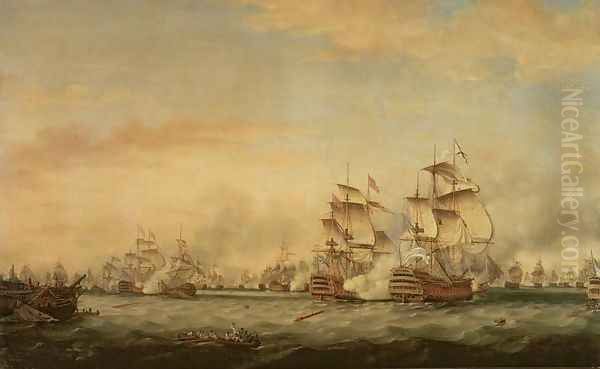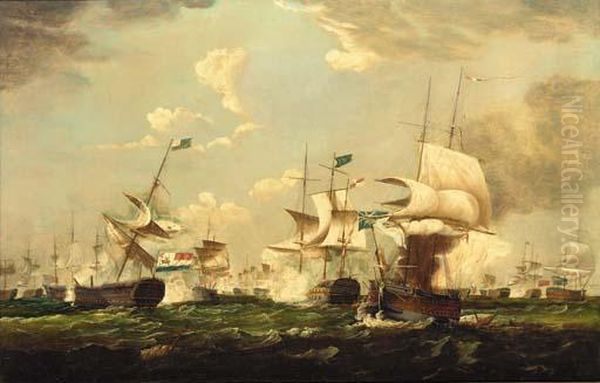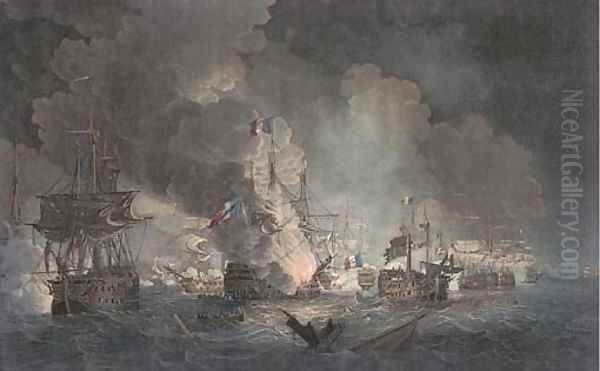Thomas Whitcombe stands as a significant figure in the rich tradition of British marine painting. Active during a pivotal era of maritime history, spanning the late eighteenth and early nineteenth centuries, Whitcombe dedicated his artistic talents primarily to depicting the power and drama of the sea, particularly focusing on naval warfare and the majestic ships of his time. Born in London around 1763, he lived and worked through a period defined by intense international conflict, including the American War of Independence, the French Revolutionary Wars, and the Napoleonic Wars, all of which provided dramatic subject matter for his canvases. His death in 1824 marked the end of a prolific career that left behind a valuable visual record of Britain's naval prowess and maritime life.
Whitcombe's paintings are celebrated for their meticulous attention to detail, dynamic compositions, and ability to convey the atmosphere of the ocean, whether in calm or storm, peace or battle. He possessed a remarkable skill for accurately rendering the complex structures of sailing ships, from the intricate rigging to the specific details of flags and naval uniforms. This accuracy, combined with a flair for dramatic presentation, made his work highly sought after and ensures its continued relevance for both art lovers and naval historians today.
Obscure Beginnings and Artistic Formation
Despite Thomas Whitcombe's considerable output and reputation during his lifetime, details regarding his early life and artistic training remain frustratingly scarce. It is generally accepted that he was born in London, likely around 1763, although some sources suggest a specific date of May 19th, this lacks definitive confirmation. Unlike some of his contemporaries whose apprenticeships or early influences are well-documented, Whitcombe's path to becoming a preeminent marine painter is largely unrecorded.

Some accounts suggest that his initial artistic endeavours may have involved painting theatrical scenery or even portraits before he found his true calling in marine subjects. This would not have been an unusual trajectory for an artist of the period, providing foundational skills in composition and representation. However, concrete evidence for this early phase is lacking. What is clear is that by 1783, Whitcombe had established himself sufficiently to begin exhibiting at the prestigious Royal Academy of Arts in London, marking the public commencement of a long and productive career focused almost exclusively on the sea.
His emergence coincided with a flourishing period for marine art in Britain, spurred by national pride in naval achievements and a growing market for images celebrating maritime power and commerce. He entered a field populated by established figures, yet quickly carved out his own niche through a combination of technical skill and a keen eye for narrative detail. The lack of information about his training suggests he may have been largely self-taught in the specifics of marine art, possibly honing his skills through direct observation and the study of works by earlier masters, such as the Dutch Golden Age painters like Willem van de Velde the Elder and Younger, whose influence permeated British marine painting.
The Signature Style: Accuracy and Drama
Thomas Whitcombe developed a distinctive artistic style characterized by a careful balance between topographical accuracy and dramatic effect. His primary focus was on the faithful representation of naval vessels. He demonstrated an exceptional understanding of ship construction, rigging, and the way sails responded to the wind. This technical precision extended to the depiction of flags, pennants, and the details of naval uniforms visible on deck, making his works valuable historical documents.
Beyond mere accuracy, Whitcombe infused his paintings with a sense of dynamism and atmosphere. His seascapes are rarely static; waves crash against hulls, spray flies, and the changing conditions of light and weather are skillfully rendered. In his battle scenes, this dynamism reaches its peak. He masterfully captured the chaos and intensity of naval engagements, depicting billowing smoke from cannon fire, splintering wood, damaged sails, and the general turmoil of combat at sea. He used light and shadow effectively to highlight key elements and create a sense of depth and drama.

His colour palette was often clear and vibrant, particularly in his handling of the sea and sky, employing rich blues and greens contrasted with the warm tones of wooden hulls and the white of sails and smoke. While adhering to the conventions of marine painting prevalent in his era, Whitcombe's work often possesses a clarity and crispness that distinguishes it. He managed to convey the grandeur and power of the Royal Navy's ships without sacrificing the specific details that lend authenticity to his scenes. This combination of accuracy, atmospheric effect, and dramatic composition became the hallmark of his successful career.
Chronicling Naval Warfare
The core of Thomas Whitcombe's artistic output lies in his depiction of naval battles and actions. Living through an era almost constantly marked by war at sea, he had no shortage of subject matter. His career spanned the latter stages of the American War of Independence, the entirety of the French Revolutionary Wars (1792-1802), and the Napoleonic Wars (1803-1815), as well as the War of 1812 between Britain and the United States. Whitcombe meticulously documented numerous key engagements from these conflicts.
His works often depicted large fleet actions, capturing the scale and complexity of battles involving numerous ships of the line. He also excelled at portraying single-ship duels, highlighting the tactical maneuvering and destructive power involved in these more intimate confrontations. These paintings served not only as artistic creations but also as visual records, celebrating British victories and commemorating the bravery of naval officers and crews. Patrons often included naval officers wishing to immortalize their participation in specific actions, or publishers seeking illustrations for popular accounts of the wars.
Whitcombe's approach involved careful research to ensure accuracy in depicting the specific ships involved, their relative positions, and the key moments of an engagement. While he likely did not witness most of these battles firsthand (unlike Nicholas Pocock, who sometimes did), he would have relied on official reports, eyewitness accounts, ship plans, and possibly sketches provided by participants to reconstruct the scenes with remarkable fidelity. His ability to translate these accounts into compelling visual narratives cemented his reputation as a leading naval painter.
Notable Works and Depictions
Among Thomas Whitcombe's extensive body of work, several paintings stand out either for their artistic merit or their historical significance. One of his early notable subjects was The Defeat of the Floating Batteries at Gibraltar, 14 September 1782. This event, part of the Great Siege of Gibraltar during the American War of Independence, was a significant British success and a popular subject for artists. Whitcombe's rendition captured the dramatic night-time scene with the Spanish floating batteries ablaze under fire from the Gibraltar garrison.

Another major engagement he depicted was the Battle of the Saints, fought in the Caribbean in April 1782, where Admiral Sir George Rodney secured a decisive victory over the French fleet under the Comte de Grasse. Whitcombe painted several versions and aspects of this battle, showcasing the breaking of the French line, a key tactical moment. These works exemplify his skill in handling complex multi-ship compositions and conveying the intensity of a large-scale fleet action.
His painting A Navy Yacht Flying The White Ensign showcases his ability to depict vessels in calmer conditions, focusing on the elegance and precision of naval architecture and ceremony. The work highlights the sleek lines of the yacht and the meticulous rendering of its sails and rigging, set against a dynamic sea, demonstrating his versatility beyond battle scenes. He also painted numerous actions from the Napoleonic Wars, such as engagements involving famous ships like HMS Victory, and documented encounters from the War of 1812, providing valuable British perspectives on that conflict. Many of his works were translated into engravings, further disseminating his images.
Beyond the Battlefield: Ship Portraits and Views
While best known for his dramatic battle scenes, Thomas Whitcombe's oeuvre also included other forms of marine art. He was frequently commissioned to paint 'portraits' of specific vessels. These could be naval warships, but also included merchant ships, East Indiamen, and private yachts. In these works, the emphasis was on the accurate and often flattering depiction of the vessel itself, usually shown under sail in favourable conditions. These portraits were popular with ship owners, captains, and merchants involved in maritime trade.
Whitcombe also produced coastal views and harbour scenes. Some of his works depict identifiable locations around the British Isles, suggesting travels to places like Bristol and the Devon coast, as inferred from the subject matter in the initial information provided. These scenes often included shipping activity, blending landscape elements with his expertise in marine subjects.
Furthermore, the mention of works depicting locations such as the Cape of Good Hope, Madeira, Cape Verde, and Puerto Rico suggests a broader geographical scope in his subject matter. It is uncertain whether Whitcombe actually travelled to these distant places himself, which would have been significant undertakings. It is perhaps more likely that he worked from sketches made by naval officers or other travellers, or based his depictions on existing prints and descriptions, a common practice among artists at the time. Regardless of the method, these works demonstrate his ability to evoke different maritime environments beyond British waters.
Recognition at the Royal Academy
Thomas Whitcombe's long association with the Royal Academy of Arts in London is a testament to his standing within the contemporary art world. He exhibited regularly and frequently at the Academy's prestigious annual exhibitions for over four decades, from 1783 until the year of his death, 1824. In total, he showed at least 56 works there during his career, a significant number that underscores his consistent productivity and the acceptance of his work by the Academy's selection committees.
The Royal Academy exhibition was the premier showcase for artists in Britain. To exhibit there was crucial for gaining visibility, attracting patrons, and building a professional reputation. Whitcombe's sustained presence indicates that his detailed and dramatic marine paintings resonated with the tastes of the time and were held in high regard by his peers and the public. His exhibits would have included many of his important naval battle scenes, ship portraits, and potentially some of his coastal views.
Exhibiting alongside the leading artists of the day, including portraitists like Sir Thomas Lawrence and landscape painters like J.M.W. Turner (who himself tackled naval themes), placed Whitcombe firmly within the mainstream of British art. His Royal Academy contributions helped solidify the genre of marine painting as a respected and popular field, celebrating Britain's identity as a dominant maritime nation.
'The Naval Achievements of Great Britain'
One of Thomas Whitcombe's most significant contributions to the visual record of naval history came through his involvement with the publication The Naval Achievements of Great Britain and Her Allies from 1793 to 1817. Published by J. Jenkins around 1817, this celebrated work featured a series of aquatint engravings depicting major naval victories and actions from the French Revolutionary and Napoleonic Wars. Whitcombe was the principal artist, providing the original paintings for fifty of the plates included in the volume.
This commission was a major undertaking and reflects Whitcombe's preeminence as a naval painter. The publication aimed to create a comprehensive visual chronicle of Britain's naval triumphs during this critical period. Each plate was accompanied by descriptive text detailing the engagement. The use of aquatint, a printmaking technique capable of rendering tonal washes similar to watercolour, allowed for faithful reproductions of Whitcombe's detailed compositions and atmospheric effects.
The Naval Achievements was highly successful and played a crucial role in shaping public memory and perception of the naval wars. Whitcombe's images, disseminated through this publication, became some of the most iconic representations of battles like the Glorious First of June, Camperdown, the Nile, Copenhagen, and Trafalgar (though depictions of Trafalgar itself were often dominated by artists like Turner and Robert Dodd). His work for Jenkins cemented his legacy as a key illustrator of this era of naval history, making his interpretations accessible to a wider audience beyond those who could acquire original paintings.
Whitcombe and His Contemporaries
Thomas Whitcombe worked within a vibrant community of marine artists in Britain. His career overlapped with several other notable practitioners of the genre, creating a rich context for his own contributions. Among his direct contemporaries specializing in naval scenes were Nicholas Pocock (1740-1821), who often brought firsthand naval experience to his detailed works, and Robert Dodd (1748-1815), known for his dramatic and commercially successful prints of naval battles, particularly those published soon after the events occurred.
Thomas Luny (1759-1837), another prolific marine painter based in Devon, also covered similar subject matter. Francis Holman (fl. 1767-1790) was an important figure in the generation preceding Whitcombe, known for his ship portraits and shipping scenes. Whitcombe's style can be seen as building upon the foundations laid by earlier artists like Charles Brooking (c.1723-1759) and Dominic Serres the Elder (1719-1793), who served as Marine Painter to King George III and brought a certain elegance to the genre.
Other marine specialists active during parts of Whitcombe's career include Dominic Serres' son, John Thomas Serres (1759-1825), Robert Cleveley (1747-1809), and William Anderson (1757-1837), who often focused on coastal and river scenes with shipping. Looking slightly later, George Chambers (1803-1840) and Clarkson Stanfield (1793-1867) would continue the tradition, sometimes with a more romantic sensibility.
Beyond marine specialists, Whitcombe's era was dominated by giants in other fields whose work provides context. The great landscape painter J.M.W. Turner (1775-1851) famously tackled naval themes, including his monumental Battle of Trafalgar. Portrait painters like Sir Joshua Reynolds (1723-1792), George Romney (1734-1802), John Hoppner (1758-1810), and Sir Thomas Lawrence (1769-1830) captured the likenesses of the naval heroes whose actions Whitcombe depicted on the waves. Whitcombe's specific contribution lies in his consistent focus on detailed, accurate, yet dramatic representations of ships and naval actions.
Later Life and Legacy
Information regarding Thomas Whitcombe's later personal life remains as elusive as details of his youth. While the initial provided text included extensive details about marriages and children, these appear to relate to a different Thomas Whitcomb(e) lineage, primarily based in America, given the dates and locations mentioned (marriages in 1810, 1832, 1859; locations like Richmond, VA; events in 1865, 1883, 1898). These details are inconsistent with the known biography of the London-based painter who died in 1824. For the artist Thomas Whitcombe, records of marriage or children are scarce or non-existent in standard art historical sources.
What is documented is that despite his prolific output and apparent success in securing commissions and exhibiting regularly, Whitcombe faced financial difficulties later in his career. Records indicate he may have been declared bankrupt around 1806. This suggests that the life of even a well-regarded artist could be precarious. Nevertheless, he continued to paint and exhibit until his death in 1824. The circumstances surrounding his final years and death are not widely documented.
Thomas Whitcombe's legacy, however, is secure. He remains one of the most important and prolific British marine painters of his generation. His vast body of work provides an invaluable visual record of the Royal Navy during a period of intense activity and national significance. His paintings are prized for their historical accuracy, particularly in the depiction of ships, naval actions, and maritime life.
His works are held in major public collections worldwide, including the National Maritime Museum in Greenwich, Tate Britain in London, the National Library of Australia, and various naval museums and art galleries in the UK, the United States, and elsewhere. His paintings continue to be sought after by collectors of marine art. Thomas Whitcombe's enduring importance lies in his ability to combine meticulous documentation with compelling artistry, creating a powerful and lasting chronicle of Britain's age of sail and naval dominance.